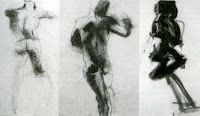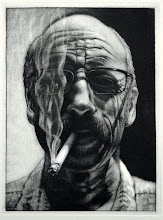
In a few more days, the evening drawing class will begin working from a live model. We've been exploring gesture during the last few classes in preparation. Everyone in class has now had experience doing short poses, so the empathetic process is starting to solidify. After last Thursday's session, I think many were exhausted by the end. We all stood at the drawing horses instead of sitting, allowing the gestural process to become more animated.
When a live model assumes a pose, especially the short ones for gestures, it's not a bad plan for those of us who are drawing to twist or bend in a similar pose to help us understand the nature of the movement the model is making, helping us to empathize with that energy. Then when we look up and down the figure it might be a little easier to see - even imagine - the line in the pose that summarizes the main force of the gesture. It might be the arc of the back, or a strong diagonal line through the torso and down one leg, such as in a contraposto position. Ideally, that line that we find will have a strong role to play in the model's movement: twisting, bending, turning. Then using your whole arm, not just your wrist, draw that line, that energy. Again, we're not worrying about detail here, we want the energy and the character of the movement. Stating the contour doesn't do it, we have to work from the inside out.
After that first forceful line, we continue searching with both our physical vision and our drawing utensil to find another complimentary and energetic line in the pose to include with the first; not thinking, just drawing, but maintaining the same priority of the energy of the pose, and of that first line Keeping a fast pace, we add other parts, but not as arms, legs, hair, etc., but rather as lines of energy that act in tandem with those already on the page.
Gesture drawing is an excellent warm up exercise every time we draw, even when we're working on something less animated than a live model. See you in the studio.

I am still trying to work texture into my work. I really do like the gesture technique. Although I am horrible at it, I think it gives off a really cool textural look. In this picture the shading looks very nice, this is something I always need help on, but I am slowly working towards it.
ReplyDeleteI also have trouble with getting the right amount of texture in my drawings. I always want to blend. The gesture drawings are a great way to look for the texture of an object.
ReplyDeleteI need to work on my gesture drawings. I have tendency to get tight very quickly. I like the energy other peoples drawings have when they use lots of squiggly lines to fill in the mass of the body. I usually draw the contours and then fill in with shading and I feel that it lacks energy.
ReplyDeleteI find gesture drawing to be the most demanding thing that I try, not only is it hard for me to get away from contour drawing but it is physically taxing on me also. Hope I can get into the swing of it a little better.
ReplyDeleteI'm starting to get the gesture stuff but for some reason I just don't like it. I always want to be picking my pencil up instead of leaving it on the papar, I struggle with that and going fast enough.
ReplyDeleteI think gesture drawings are beautiful works of art in themselves. I would love to make a sketchbook of just gestures just to flip through somtimes or just for reference. It might be because I like to work with the human form more than anything.
ReplyDeleteI don't think that I could do life drawings. I am more of a "looking at a picture" type person.
ReplyDeleteI like the idea of doing the same pose with our own bodies to get the feel for the pose...that might help me get the gesture down.
ReplyDeleteI did not take this class, but i agree with the artist putting themselves in the pose while trying to capture gesture. I think it only helps to stand and move while drawing gestures. To feel the pose is to understand the pose and that is how we capture the pose.
ReplyDelete